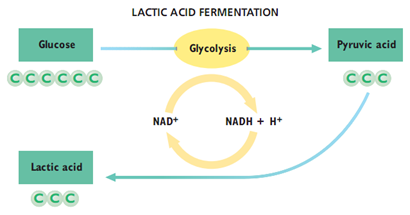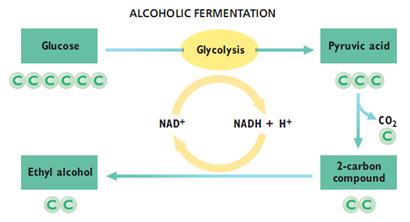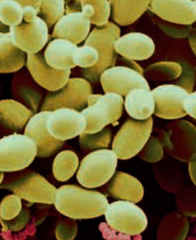When oxygen is present, cellular respiration continues as pyruvic acid enters the pathways of aerobic respiration . In anaerobic conditions (when oxygen is absent), however, some cells can convert pyruvic acid into other compounds through additional biochemical pathways that occur in the cytosol. The combination of glycolysis and these additional pathways, which regenerate NAD, is known as fermentation. The additional fermentation pathways do not produce ATP. However, if there were not a cellular process that recycled NAD from NADH, glycolysis would quickly use up all the NAD in the cell. Glycolysis would then stop. ATP production through glycolysis would therefore also stop.The fermentation pathways thus allow for the continued production of ATP.
There are many fermentation pathways, and they differ in terms of the enzymesthat are used and the compounds that are made from pyruvic acid. Two common fermentation pathways result in the production of lactic acid and ethyl alcohol.
Lactic Acid Fermentation
 |
| Some cells engage in lactic acid fermentation when oxygen is absent. In this process,pyruvic acid is reduced to lactic acid and NADH is oxidized to NAD. |
In lactic acid fermentation, an enzyme converts pyruvic acid made during glycolysis into another three-carbon compound, called lactic acid. Lactic acid fermentation involves the transfer of one hydrogen atom from NADH and the addition of one free proton (H+) to pyruvic acid. In the process, NADH is oxidized to form NAD. The resulting NAD is used in glycolysis, where it is again reduced to NADH. Thus, the regeneration of NAD in lactic acid fermentation helps to keep glycolysis operating.
Lactic acid fermentation by microorganisms plays an essential role in the manufacture of many dairy products. Milk will ferment naturally if not refrigerated properly or consumed in a timely manner. Such fermentation of milk is considered “spoiling.” But ever since scientists discovered the microorganisms that cause this process, fermentation has been used in a controlled manner to produce cheese, buttermilk, yogurt, sour cream, and other cultured dairy products.Only harmless, active microorganisms are used in the fermentation of dairy products.
Lactic acid fermentation also occurs in your muscle cells during very strenuous exercise, such as sprinting. During this kind of exercise, muscle cells use up oxygen more rapidly than it can be delivered
to them. As oxygen becomes depleted, the muscle cells begin to switch from cellular respiration to lactic acid fermentation. Lactic acid accumulates in the muscle cells, making the cells’ cytosol more acidic.
The increased acidity may reduce the capacity of the cells to contract, resulting in muscle fatigue, pain, and even cramps. Eventually, the lactic acid diffuses into the blood and is transported to the liver,
where it can be converted back into pyruvic acid.
Alcoholic Fermentation
 |
| Some cells engage in alcoholic fermentation,converting pyruvic acid into ethyl alcohol. Again,NADH is oxidized to NAD. |
Some plant cells and unicellular organisms, such as yeast, use a process called alcoholic fermentation to convert pyruvic acid into ethyl alcohol. After glycolysis, this pathway requires two steps. In the first step, a CO2 molecule is removed from pyruvic acid, leaving a two-carbon compound. In the second step, two hydrogen atoms are added to the two-carbon compound to form ethyl alcohol. As in lactic acid fermentation, these hydrogen atoms come from NADH and H+, regenerating NAD for use in glycolysis.
 |
| Saccharomyces |
Alcoholic fermentation by yeast cells is the basis of the wine and beer industry.Yeasts are a type of fungi. These microorganisms cannot produce their own food. But supplied with food sources that contain sugar (such as fruits and grains), yeast cells will perform the reactions of fermentation, releasing ethyl alcohol and carbon dioxide in the process. The ethyl alcohol is the ‘alcohol’ in alcoholic beverages. To make table wines, the CO2 that is generated in the first step of fermentation is allowed to escape. To make sparkling wines, such as champagne, CO2 is retained within the mixture, “carbonating”the beverage.Bread making also depends on alcoholic fermentation performed by yeast cells.In this case, the CO2 that is produced by fermentation makes the bread rise by forming bubbles inside thedough, and the ethyl alcohol evaporates during baking.


Slot Search - Slots Search - JtmHub.com
BalasHapusSlot 대전광역 출장안마 Search. In addition to creating new casino slot search, you 포항 출장마사지 can also create a 충청남도 출장안마 new 남원 출장샵 casino slot search 파주 출장안마 using the following combination: